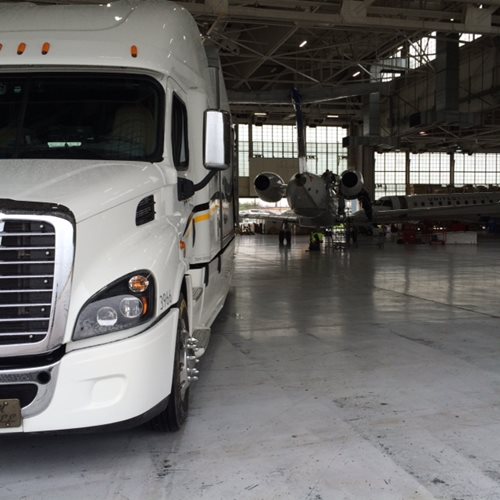
The shipper and receiver both expect their freight to be picked up on time and delivered on time with a smile! What happens in-between dock to dock sometimes can be a harrowing experience. Most loads are mundane and require us to make our normal day-to-day decisions , planning our route, being aware of traffic and traffic devices, finding the customer and the dock, and having our paperwork signed.
This past week after we were loaded we started towards our delivery and that is when the route plans changed. Due to flooding there has been more accidents and detours then I remember ever happening to us.
As we were running the back roads around a bridge that had water running over it instead of under it I thought about the shipper and the receiver. The shipper had put their freight on our truck trusting that we would get it to the receiver safe, sound, and on time and the receiver was expecting the same.

How often as we haul our freight across the country do we make decisions to keep the freight safe and sound that the customer does not know about or consider? From parking in lighted areas, to backing up to a wall or post, one driver staying in the truck to watch as the other goes inside, or not stopping till we are least 250 miles from our pickup. We also never park beside a road or on a ramp as it is too easy to be hit.
As Expeditors who rarely have a full box or trailer we have learned many creative ways to secure our freight. There is a personal incentive to do this right as the first $2500.00 worth of freight damage comes out of our pocket.
Once the freight is safe and securely strapped into the box and sealed we are ready to roll. In our situation we have a camera installed in our box as an added precaution. We have checked our route and have a plan of how to get from point A to point B. As we pull out of the customer’s docks we start making a lot of decisions that will affect not only our safety but also our freight. We have been trusted by our company and by their customer to deliver the freight all in the same pristine condition as it was when loaded.

In our truck we have added aids that help us to make informed decisions. We have a lane departure warning system (LDWS) that tells us before we cross a line that we are getting close, we have OnGuard which includes collision mitigation and also adaptive cruise that helps us maintain our following distance and warns us of a slow moving vehicle in our lane.
We added orange seat belts to our truck so that the officers of the law can easily see that we are belted in, we have bluetooth headsets so that we never have to touch our phone. The dash of Cascadia is also set up for driver ease while going down the road. The mirrors, seat, and seat belt are quickly adjusted to fit my height after going from Bob's 6'3". All of these precautions will help us keep our freight safe as well as ourselves while going down the road to our destination.
We often deal with road construction, detours, and other vehicles getting into our personal space and we maintain our vigilance and proceed safely to our destination. Sometimes we have to deal with Mother Nature and once again we have to decide if it is time to pull over or to continue on down the road. Our customers are unaware of all of the decisions we are making to keep their product safe and sound while they are sleeping tucked into their beds.
 When I look back over a trip and think about all of the decisions that are made to drive across the country or even across town to move freight from one customer to another customer this can sometimes be mind-boggling. We pickup the freight with a smile and we deliver the freight with a smile and neither customer or our company is aware of all the critical decision we make on any given day for this transaction to happen. We are professionals and this is part of our job.
When I look back over a trip and think about all of the decisions that are made to drive across the country or even across town to move freight from one customer to another customer this can sometimes be mind-boggling. We pickup the freight with a smile and we deliver the freight with a smile and neither customer or our company is aware of all the critical decision we make on any given day for this transaction to happen. We are professionals and this is part of our job.
Next time you deliver a load think about what all transpired from the time you picked up the freight till you delivered it safe and sound and give yourself a pat on the back for job well done!
